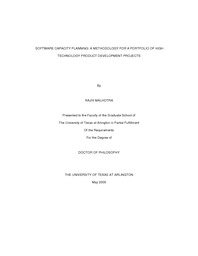
ATTENTION: The works hosted here are being migrated to a new repository that will consolidate resources, improve discoverability, and better show UTA's research impact on the global community. We will update authors as the migration progresses. Please see MavMatrix for more information.
Show simple item record
| dc.contributor.author | Malhotra, Rajiv | en_US |
| dc.date.accessioned | 2009-09-16T18:18:53Z | |
| dc.date.available | 2009-09-16T18:18:53Z | |
| dc.date.issued | 2009-09-16T18:18:53Z | |
| dc.date.submitted | January 2009 | en_US |
| dc.identifier.other | DISS-10268 | en_US |
| dc.identifier.uri | http://hdl.handle.net/10106/1710 | |
| dc.description.abstract | High technology product development projects make extensive use of engineering software during the product development process. The suite of engineering software tools deployed during product development represents a significant portion of the product development costs. The ability to forecast the engineering software license capacity required to support product development plans is crucial for budgeting, return on investment (ROI) calculations, contract negotiations with the software suppliers, and the provision of an IT infrastructure necessary to support the execution of the software tools. This research shows that the usage of engineering application software in high technology is cyclical due to the characteristics of high technology product development. A rigorous methodology to compute the cycle boundaries based on usage history is proposed. Information of the usage cycles is used to modify the existing trend forecast to increase the prediction accuracy of future usage predictions. Data of the current usage of the projects in execution is then used to forecast the overall software capacity needed to support all current projects. Cyclic usage patterns also predict how the usage is expected to change in the future for the time period under study. Usage data is collected for the three main projects concurrently in execution. Of the three, one of the projects goes through its full development cycle. In this research we show (a) a rigorous methodology using Fourier analysis to extract the cyclical variations of the project that goes through its full development cycle and (b) the application of the cyclical variations to a trend forecast to improve the quality of the forecast.Single project forecasts are then combined to generate an overall engineering software capacity forecast for the enterprise. All engineering software licenses for both project and non-project work are shared by the enterprise from a central license pool. To determine the enterprise capacity requirement, the relationship between the key individual projects and the total usage is determined and used to predict future capacity. | en_US |
| dc.description.sponsorship | Liles, Donald | en_US |
| dc.language.iso | EN | en_US |
| dc.publisher | Industrial & Manufacturing Engineering | en_US |
| dc.title | Software Capacity Planning: A Methodology For A Portfolio Of High Technology Product Development Projects | en_US |
| dc.type | Ph.D. | en_US |
| dc.contributor.committeeChair | Liles, Donald | en_US |
| dc.degree.department | Industrial & Manufacturing Engineering | en_US |
| dc.degree.discipline | Industrial & Manufacturing Engineering | en_US |
| dc.degree.grantor | University of Texas at Arlington | en_US |
| dc.degree.level | doctoral | en_US |
| dc.degree.name | Ph.D. | en_US |
| dc.identifier.externalLink | http://www.uta.edu/ra/real/editprofile.php?onlyview=1&pid=261 | |
| dc.identifier.externalLinkDescription | Link to Research Profiles | |
Files in this item
- Name:
- Malhotra_uta_2502D_10268.pdf
- Size:
- 2.510Mb
- Format:
- PDF
This item appears in the following Collection(s)
Show simple item record


